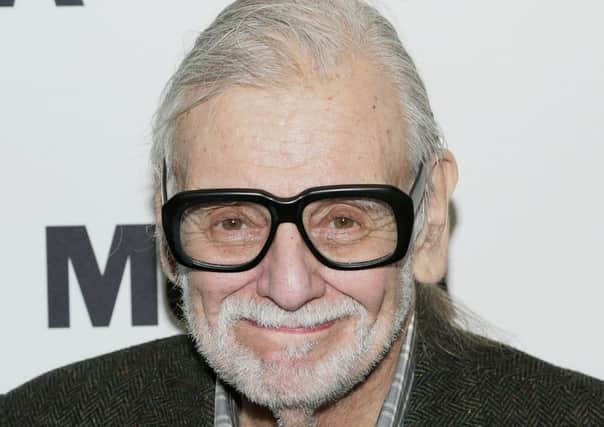Obituary: George A Romero, film-maker who brought social commentary to the horror genre


George A Romero, whose classic Night of the Living Dead and other horror films turned zombie movies into social commentaries and who saw his flesh-devouring undead spawn countless imitators, remakes and homages, has died. He was 77.
Romero died on Sunday following a battle with lung cancer, said his family. They added that he died while listening to the score of The Quiet Man, one of his favorite films, with his wife, Suzanne Desrocher, and daughter, Tina Romero, by this side.
Advertisement
Hide AdAdvertisement
Hide AdRomero is credited with reinventing the movie zombie with his directorial debut, the 1968 cult classic, Night of the Living Dead. The movie set the rules imitators lived by: Zombies move slowly, lust for human flesh and can only be killed when shot in the head. If a zombie bites a human, the person dies and returns as a zombie. Romero’s zombies, however, were always more than mere cannibals. They were metaphors for conformity, racism, mall culture, militarism, class differences and other social ills.
“The zombies, they could be anything,” Romero said in 2008. “They could be an avalanche, they could be a hurricane. It’s a disaster out there. The stories are about how people fail to respond in the proper way. They fail to address it. They keep trying to stick where they are, instead of recognising maybe this is too big for us to try to maintain. That’s the part of it that I’ve always enjoyed.”
Night of the Living Dead, made for about $100,000, featured flesh-hungry ghouls trying to feast on humans holed up in a Pennsylvania house. In 1999 the US Library of Congress inducted the black-and-white masterpiece into the National Registry of Films.
Romero’s death was immediately felt across a wide spectrum of horror fans and filmmakers. Stephen King, whose The Dark Half was adapted by Romero, called him his favorite collaborator and said, “There will never be another like you.” Guillermo del Toro called the loss “enormous.”
Romero’s influence could be seen across decades of US films, from John Carpenter to Edgar Wright. Many considered Night of the Living Dead a critique on racism in America. The sole black character survives the zombies, but he is fatally shot by rescuers.
Ten years after Night of the Living Dead, Romero made Dawn of the Dead, in which human survivors take refuge from the undead in a shopping mall, then turn on one another as the zombies stumble around the complex.
Film critic Roger Ebert called it “one of the best horror films ever made – and, as an inescapable result, one of the most horrifying. It is gruesome, sickening, disgusting, violent, brutal and appalling. It is also... brilliantly crafted, funny, droll and savagely merciless in its satiric view of the American consumer society.”
“He really was what you didn’t expect. He was incredibly gentle,” said Gaylen Ross, who starred in Dawn of the Dead and 1982’s Creepshow. “He had this optimistic purity about friendship and honor. No matter how insane the demands were on the film, I never saw a crew that was so willing to do whatever they needed for George.”
Advertisement
Hide AdAdvertisement
Hide AdRomero had a sometimes combative relationship with the genre he helped create. He called current US hit TV show The Walking Dead a “soap opera” and said big-budget films like World War Z made modest zombie films impossible. Romero maintained that he would not make horror films if he could not fill them with political statements.
“People say, ‘You’re trapped in this genre. You’re a horror guy.’ I say, ‘Wait a minute, I’m able to say exactly what I think’,” Romero said. “I’m able to talk about, comment about, take snapshots of what’s going on at the time. I don’t feel trapped. I feel this is my way of being able to express myself.”
The third in the Romero’s zombie series, 1985’s Day of the Dead, was a critical and commercial failure. There would not be another Dead film for two decades.
There were other movies, including The Crazies (1973), Martin (1977), Monkey Shines (1988) and The Dark Half (1993). There also was 1981’s Knightriders, Romero’s take on the Arthurian legend featuring motorcycling jousters. Some were moderately successful, others flops.
George Andrew Romero was born on 4 February 1940 in New York City. He grew up in the Bronx, and was a fan of horror comics and movies in the pre-VCR era. “I grew up at the Loews American in the Bronx,” he wrote in an issue of the BFI’s Sight and Sound magazine in 2002.
His favorite film was Michael Powell and Emeric Pressburger’s The Tales of Hoffman, based on Jacques Offenbach’s opera. It was, he once wrote, “the one movie that made me want to make movies”.He spoke of travelling to Manhattan to rent a 16mm version of the film from a distribution house. When the film was unavailable, Romero said, it was because another “kid” had rented it – Martin Scorsese.
Romero graduated from Carnegie Mellon University in Pittsburgh in 1960. He learned the film business working on the sets of movies and Mister Rogers’ Neighborhood, which was shot in Pittsburgh.
The city became Romero’s home, and many of his films were set in western Pennsylvania.
Advertisement
Hide AdAdvertisement
Hide AdRomero struggled to get films made late in life. The last film he directed was 2009’s Survival of the Dead, though other filmmakers continued the series with several sequels.
But Romero held strong to his principles. A movie with zombies just running amok, with no social consciousness, held no appeal, he often said. “That’s not what I’m about.”